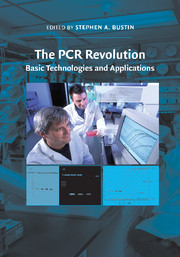Book contents
- Frontmatter
- Contents
- Contributors
- Foreword by Russell Higuchi
- Preface
- I BASIC TECHNOLOGIES
- 1 Real-time polymerase chain reaction
- 2 Thermostable enzymes used in polymerase chain reaction
- 3 Inventing molecular beacons
- 4 Rapid polymerase chain reaction and melting analysis
- 5 Polymerase chain reaction and fluorescence chemistries: deoxyribonucleic acid incarnate
- 6 Analysis of microribonucleic acid expression by quantitative real-time polymerase chain reaction
- 7 Miniaturized polymerase chain reaction for quantitative clinical diagnostics
- 8 The road from qualitative to quantitative assay: What is next?
- 9 Taking control of the polymerase chain reaction
- II APPLICATIONS
- Index
- Plate section
- References
1 - Real-time polymerase chain reaction
Published online by Cambridge University Press: 25 January 2011
- Frontmatter
- Contents
- Contributors
- Foreword by Russell Higuchi
- Preface
- I BASIC TECHNOLOGIES
- 1 Real-time polymerase chain reaction
- 2 Thermostable enzymes used in polymerase chain reaction
- 3 Inventing molecular beacons
- 4 Rapid polymerase chain reaction and melting analysis
- 5 Polymerase chain reaction and fluorescence chemistries: deoxyribonucleic acid incarnate
- 6 Analysis of microribonucleic acid expression by quantitative real-time polymerase chain reaction
- 7 Miniaturized polymerase chain reaction for quantitative clinical diagnostics
- 8 The road from qualitative to quantitative assay: What is next?
- 9 Taking control of the polymerase chain reaction
- II APPLICATIONS
- Index
- Plate section
- References
Summary
The invention and successful practice of the polymerase chain reaction (PCR) by Kary Mullis and colleagues in 1983 set the stage for a scientific revolution. PCR established a base technology from which many specific and diverse applications have grown. PCR has played a crucial underlying technological role in many aspects of the genomic age that we experience today. The power to assess complete genomic sequences starting with minuscule amounts of target molecules entrenched PCR as the backbone of many subsequent analytical techniques. The sequencing of the genomes of many diverse species and the ability to discriminate individuals within a species have relied on PCR as an instrumental component.
The knowledge of genomes has led to the ability to identify sequences representing the coding genes that carry the blueprints for the construction of proteins. It is of great scientific interest to study the regulation of these gene-encoding messenger ribonucleic (mRNA) molecules. The study of gene expression has led to a better understanding of different biological states that exist within different tissue types, reflecting their different functions. Gene expression changes provide insight into underlying molecular and functional differences that exist between diseased and normal tissues. PCR has had a profound impact on gene expression studies as well. In 1991, while I was a junior scientist at Genentech, my scientific life was intensely affected by PCR. I was part of a team charged with developing assays to assess clinical outcomes of a vaccine treatment for human immunodeficiency virus (HIV) infections.
- Type
- Chapter
- Information
- The PCR RevolutionBasic Technologies and Applications, pp. 3 - 11Publisher: Cambridge University PressPrint publication year: 2009
References
- 1
- Cited by



